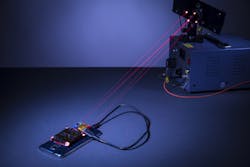| This laser-based wireless charging system was created by University of Washington engineers. The charging laser and guard lasers are normally invisible to the human eye, but red beams have been inserted here in place of the guard beams for demonstration purposes. (Image: Mark Stone/University of Washington) |
Researchers at the University of Washington (Seattle, WA) have designed and experimentally demonstrated a laser-based line-of-sight wireless power delivery system that could be used, for example, for charging smartphones and other devices.1 The researchers say that the system delivers more than 2 W of power safely over distances of 4.3 and 12.2 m for a smartphone (25 cm2) and tabletop form factor (100 cm2) receiver, respectively.
The system uses a high-power laser-diode source with a 978 nm wavelength, along with two steerable mirrors to aim the beam at the receiver; a photovoltaic cell, heatsink, and retroreflector at the receiver; and a low-power guard laser beam to serve as a safety interlock (using the retroreflector), switching the high-power laser off within 272 µs if the beam is intercepted by a human. The low-power beam is wider than the high-power beam, ensuring switch-off before the high-power beam can contact a person.
"Safety was our focus in designing this system," says Shyam Gollakota, one of the researchers. "We have designed, constructed and tested this laser-based charging system with a rapid-response safety mechanism, which ensures that the laser emitter will terminate the charging beam before a person comes into the path of the laser."
The researchers programmed the experimental smartphone to signal its location by emitting high-frequency acoustic chirps inaudible to human ears.
"The beam delivers charge as quickly as plugging in your smartphone to a USB port," says Elyas Bayati, another researcher. "But instead of plugging your phone in, you simply place it on a table."
Planar metasurface retroreflectors could be used in the future, say the researchers.
Source: http://www.washington.edu/news/2018/02/20/using-a-laser-to-wirelessly-charge-a-smartphone-safely-across-a-room/
REFERENCE:
1. Vikram Iyer et al., Proceedings of the Association for Computing Machinery on Interactive, Mobile, Wearable & Ubiquitous Technologies (2018); doi: 10.1145/3161163
